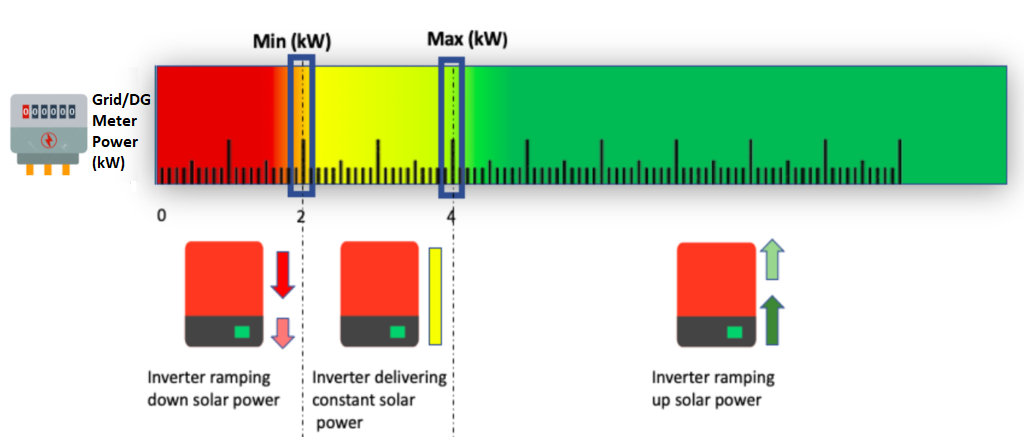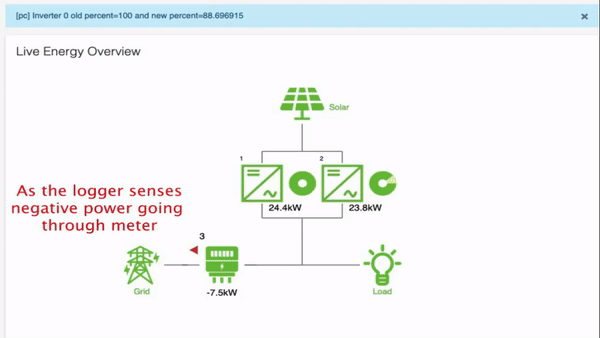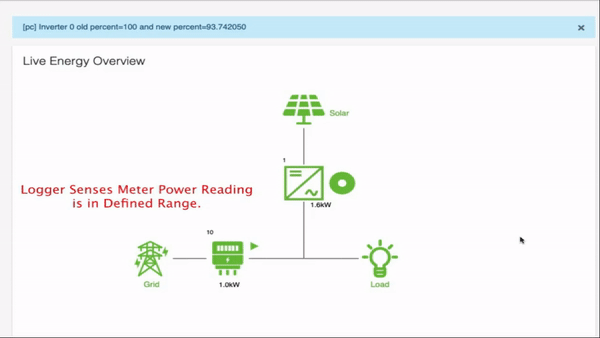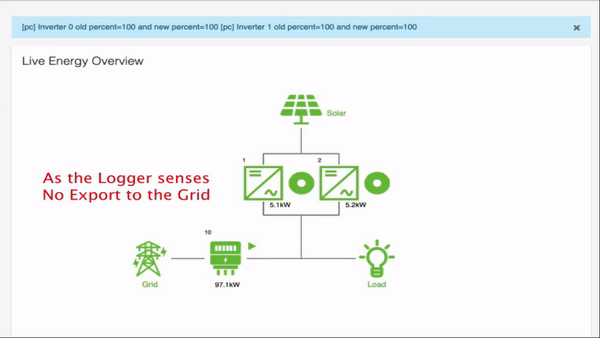How Trackso Ensures Seamless Power Control (Zero Export &DG Sync)?
How Trackso Power Control is Configured?
The functionality is set up using its web interface that limits the physical presence at the site. In order to set up power control in the device, a reference range is provided of minimum and maximum power readings at the Bi-directional meter (measuring incoming grid power in case of zero export and DG output power in case of DG Sync). The lower end of this range is referred to as Min(kW) and the higher range is set up as Max(kW).
Now, we divide the Power Control mechanism into 3 stages

General Settings- Min (kw)= 2% of total load at site, Max (kW)= 4% of total load at site.
| Cases | ZED Action | Result |
|---|---|---|
| Grid-Power>Max(kW) | ZED will send command to Inverter to work on its maximum efficiency. | This will ensure max generation from Solar PV. |
Min(kW)<Grid-Power<Max(kW) | PCD will instruct the inverter continue working with the present constant output active power. | This will ensure catering of the load variations. |
| Grid-Power<Min(kW) | ZED will instruct the inverter to ramp-down, so as to decrease the solar production in proportion to the falling rate of Grid power | Unlike, reverse relay protection, the ZED continuously monitors the falling rate of the Grid power and instructs the inverter to adjust its working efficiency, so as to completely obstruct the reverse feed in to the grid. |
General Settings- Min (kw)= 30% of DG Capacity, Max (kW)= 35% of DG Capacity
| Cases | Power Control Device (PCD) Action | Result |
|---|---|---|
| DG-Power>Max(kW) | PCD will send command to the Inverter to work on its maximum efficiency. | This will ensure max generation from Solar PV. |
Min(kW)<DG-Power<Max(kW) | PCD will instruct the inverter to continue working with the present constant output active power. | This will ensure catering of the load variations. |
| DG-Power<Min(kW) | PCD will instruct the inverter to ramp-down, so as to decrease the solar production in proportion to the falling rate of DG power | Unlike, reverse relay protection, the PCD continuously monitors the falling rate of the DG power and instructs the inverter to adjust its working efficiency, so as to completely obstruct the reverse feed in to the DG. |
Sample case for ZED use case:
Consider a solar plant of 10kWp capacity and the maximum load of 15 kWp. Also, let’s set the minimum set point to 0.5 kWp and the maximum set point to 1 kWp. Considering the the load required at any time is 7kWp and solar is producing 8kWp, then the TrackSo ZED will command the solar system to cut down the power production to reach 7kWp. On the other hand, if the load is 11kWp and the solar system is producing 8kWp, the TrackSo ZED will keep running the solar system to it’s full potential while the rest of the required power will come from the grid i.e. 3kWp.
Now, if while reducing the power output of the solar system, the grid input power falls anywhere within the range of min and max set point, the TrackSo ZED will stop commanding solar system to change power output.
Features of Zero Export Device (ZED):
Smart Control : The device will ensure that the inverter ramps down the solar production smartly, by continuously analyzing the grid meter reading.
Ensure Zero Protection: Unlike reverse relay protection, our device ensures that the inverter doesn’t trip and minimum or no reverse feed in is sent back to the grid at any given point.
Graphical Illustration: At any time client can log in to its device locally or via Trackso PCD web interface and see the graphical illustration of power control working.
Visualization of all 3 Possible cases
Condition 1 : When the Output Power of Bidirectional Meter is less than ‘Defined Range’.
In this condition when the ZED senses that the reading of bidrectional meter is going less than the defined ‘Minimum’ in the power control algorithm, It sends throttle down command to the ZED (refer the % wise power control commands in blue bar). The cycle repeats after every 5 sec, till the reading of bidirectional meter is not in ‘defined’ range.

Condition 2 : When the Output Power of Bidirectional Meter is in the Defined ‘Range’.
As the ZED senses the reading of the bidirectional meter to be within the ‘defined range’, the control command of the ZED instructs the inverter to withhold the generation to the current state, until the next command arrives.

Condition 3 : When the Output Power of Bidirectional Meter is well above the ‘Defined Range’
In the last case, as the ZED senses the reading of the bidirectional meter is above the ‘defined range’, the ZED instructs the inverter to let loose and work at their maximum (i.e: 100%) efficiency.

